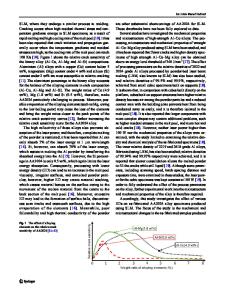Evaluating the impacts of laser process parameters on microstructure and microhardness of H13-TiC composite using the ma
- PDF / 3,450,375 Bytes
- 14 Pages / 595.276 x 790.866 pts Page_size
- 0 Downloads / 291 Views
Evaluating the impacts of laser process parameters on microstructure and microhardness of H13‑TiC composite using the mathematical modelling Maryam Kazemi1 · Hassan Saghafian1 · Milad Hooshyar2 Received: 2 May 2020 / Accepted: 28 September 2020 © Springer Nature Switzerland AG 2020
Abstract To achieve an optimum microstructure and hardness of the H13-TiC composite, we aim to optimize and improve the laser process parameters of the composite. In the beginning, TiC particles due to important properties such as high hardness, high modulus, low density and high thermal stability were successfully deposited on the H13 hot work tool steel using a pulse Nd: YAG laser. In the deposition process, laser scanning speeds of 2, 7 and 12 mm/s, pulse widths of 6, 8 and 10 ms and operational distances of 4, 5 and 6 mm were used. Then, the response surface methodology was used to find the relationships between three independent variables, develop a mathematical model, better understand the simultaneous effects of variables on the properties of composite area and achieve the optimal values of these variables. XRD and EDS were used to identify the phases, and FESEM and SEM were applied to evaluate the microstructure. The obtained results demonstrate that optimal conditions for the desirable microstructure on the composite surface are achieved at the scanning speed, pulse width and operational distance of 12 mm/s, 9.96 ms and 5.94 mm, respectively. Therefore, using this condition, the microhardness of 1606.49 Vickers is obtained. Keywords H13-TiC composite · Response surface method (RSM) · Scanning speed · Pulse width · Operational distance · Microstructure
1 Introduction Over the last few decades, due to its remarkable hot strength and astounding toughness, steel H13 has been used in various industries, including extruding tools, hotforging and casting dies [1–3]. Such tools must be resistant at the heavy loads, without failure and without excessive deformation and wear. One solution to solve these problems is to incorporate second-phase particles into the steel matrix. For this purpose, a new class of materials called
metal matrix composites has emerged which signify notable wear and erosion resistances, higher hardness and stiffness at a lower density in comparison to the matrix. Existence of ceramic particles leads to a decrease in the matrix ductility and improves anisotropy in properties [4–6]. It has been reported that the addition of the thermodynamically stable TiC particles into a hard martensitic matrix leads to a meaningful increase in features like hardness, stiffness and wear resistance [7]. The need for improving the performance and extending the service life of the components
All authors have contributed to the study conception and design. Material preparation, data collection and analysis were performed by Maryam kazemi, Hassan Saghafian, Milad Hooshyar. The first draft of the manuscript was written by Maryam kazemi and all authors commented on previous versions of the manuscript. All authors read and approved th
Data Loading...











